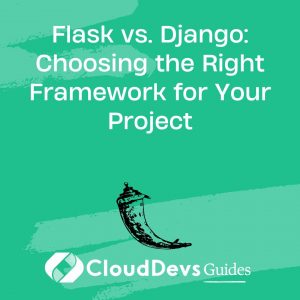Flask vs. Django: Choosing the Right Framework for Your Project
When it comes to web development in Python, Flask and Django are two of the most popular frameworks. Both have their strengths and are widely used in the industry. But how do you choose the right framework for your project? In this blog, we will compare Flask and Django based on different factors to help you make an informed decision.
Overview
Flask and Django are web frameworks that simplify the process of building web applications in Python. While Flask is a microframework, providing flexibility and simplicity, Django is a full-featured framework that follows the “batteries included” philosophy, offering a robust set of tools and features out of the box. The choice between the two depends on the specific needs and requirements of your project.
Flexibility vs. Convention
One of the primary differences between Flask and Django lies in their approach to flexibility and convention. Flask is known for its minimalist design, allowing developers to have more control over their application’s structure and design choices. It provides the basic building blocks and lets you choose the tools and libraries you prefer. On the other hand, Django follows a convention-over-configuration approach, providing a predefined structure and workflow. This can be advantageous for rapid development and easier collaboration within a team.
Flask Example
python
from flask import Flask
app = Flask(__name__)
@app.route('/')
def hello():
return 'Hello, Flask!'
Django Example
python
from django.urls import path
from django.http import HttpResponse
def hello(request):
return HttpResponse('Hello, Django!')
urlpatterns = [
path('', hello),
]
Scalability and Complexity
Django is designed to handle complex and large-scale applications effortlessly. It includes an ORM (Object-Relational Mapping) for database management, an admin interface, authentication system, and more. These features make Django an excellent choice for enterprise-level projects that require robustness and scalability. Flask, being a microframework, is more lightweight and flexible. It is suitable for small to medium-sized projects, where simplicity and customization are valued.
Ecosystem and Community
Both Flask and Django have vibrant communities and extensive ecosystems. Django has been around for a longer time, resulting in a larger community and a vast collection of reusable apps and libraries. It offers built-in solutions for common web development tasks. Flask, being a more lightweight framework, has a smaller ecosystem but still provides numerous extensions and libraries to enhance functionality. Flask’s simplicity also makes it easier to integrate with other tools and frameworks.
Learning Curve
The learning curve is another factor to consider when choosing between Flask and Django. Flask’s minimalist design makes it relatively easy to learn and understand. It allows developers to start small and gradually add features as needed. Django, on the other hand, has a steeper learning curve due to its comprehensive feature set and convention-heavy approach. However, once you become familiar with Django’s concepts and structure, it can greatly boost productivity.
Conclusion
Choosing between Flask and Django depends on your project’s requirements, complexity, and development preferences. If you value flexibility, simplicity, and customization, Flask might be the right choice. On the other hand, if you need a full-featured framework with batteries included, Django offers a robust set of tools and promotes rapid development. Consider the factors discussed in this blog to make an informed decision and build your web application with confidence.
Remember, both Flask and Django have their strengths and are widely used in the industry. The final choice should align with your project’s specific needs and your team’s expertise. Happy coding!
Table of Contents







